Easy recipe for the French classic apple dessert, the Tarte Tatin. Discover what makes it so special - from its history and name, what pan and best apples to use, plus how to make the easiest caramel.
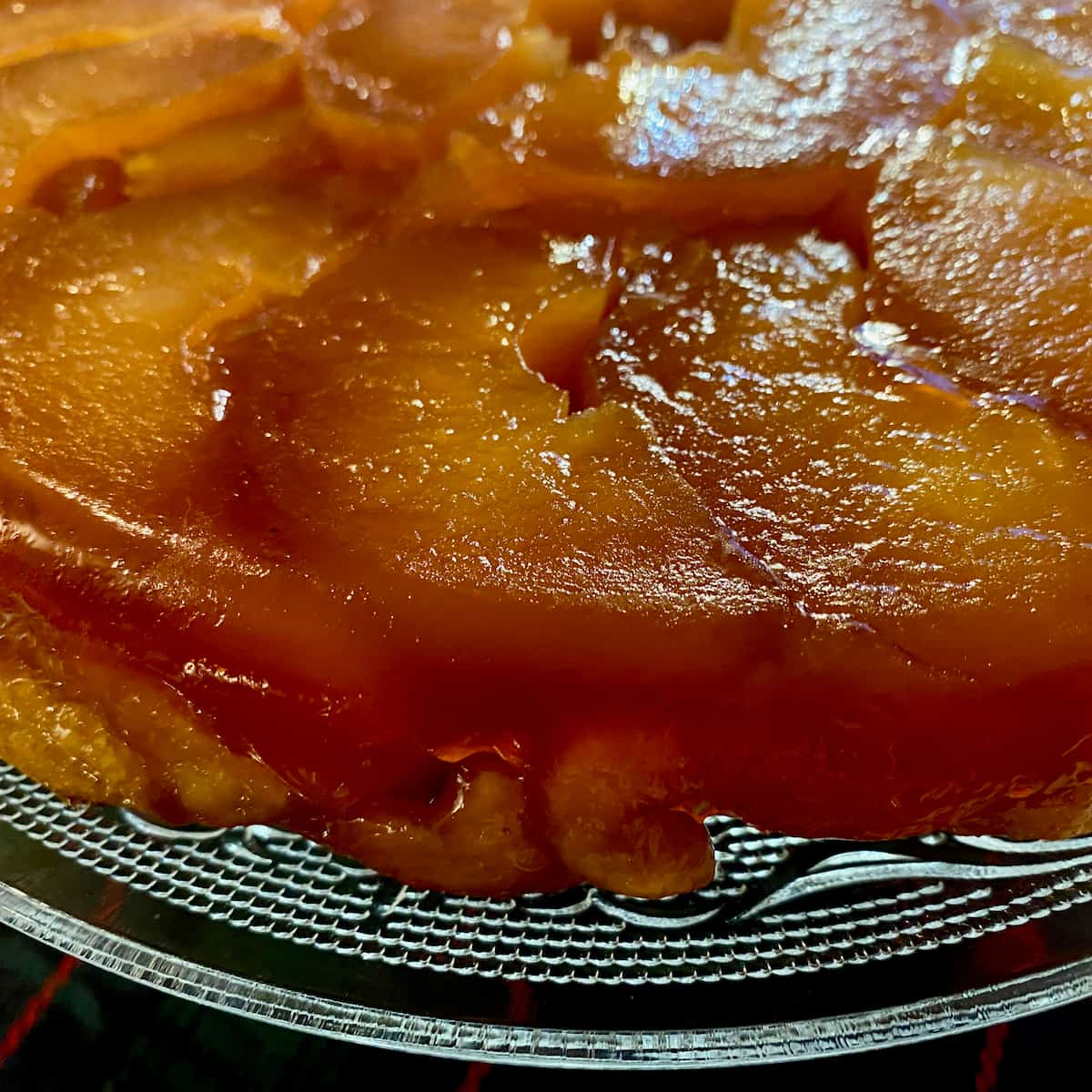
What is Special about Tarte Tatin?
It looks so complicated with all its caramel glistening over tightly-packed apples but it's so much easier than it looks.
The Tarte Tatin's special feature is that it's an upside-down tart made primarily with apples. The apples are tightly packed in a pan that have first been caramelised together. It's then covered in a layer of pastry and baked. When cool, the tart is then served after upturning the tin on to the plate.
Why do we do this? Ah, it's all down to the history of how this recipe was created - quite by accident.
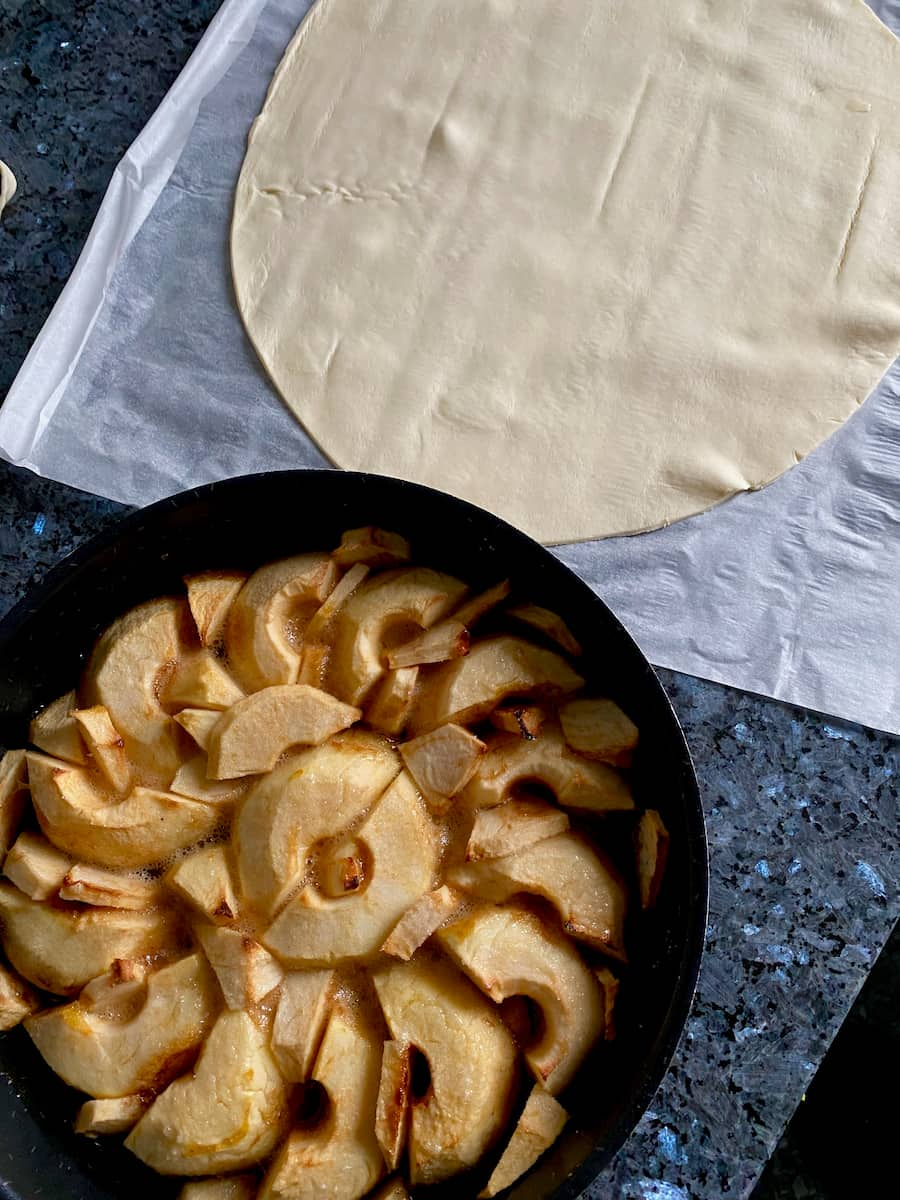
History of the French Tarte Tatin
According to my 1984 edition of Larousse Gastronomique (given as a wedding present as a young Scot about to embark in a French kitchen), the Tarte Tatin dessert was first served in Paris at Maxim's.
It's not sure if they gave a bow to its creators, the famous Tatin sisters - as they had spied on their famous new dessert and wanted to copycat it in Paris. That was the start of its popularity in France and how it got its name.
However, it was both Stéphanie Marie (1838-1917) and Geneviève Caroline Tatin (1847-1911) who created it while making a 'tarte solognote'.
They came up instead with this irresistible dessert quite by accident at the end of the 19th century. While running their hotel/restaurant in Lamotte-Beuvron, in the Sologne region, they were apparently so busy with clients at the front desk that they were often distracted.
I have two conflicting stories from many different cookbooks, but I prefer to stick with this one. As the apples were caramelising in sugar and butter in the oven for their tarte solognote, they either realised they’d forgotten the pastry or that they'd burned the apples, so they simply plopped the pastry on top, baked then flipped the tart upside down, and Mon Dieu, look what turned up?
From then on, it was served as "La Tarte de Mademoiselles Tatin" (mentioned in a local newspaper in 1889 according to 'On Va Déguster France' by François-Régis Gaudry). This tart was their speciality until they retired in 1906. They never called it a Tarte Tatin until it was renamed at Maxim's in Paris.
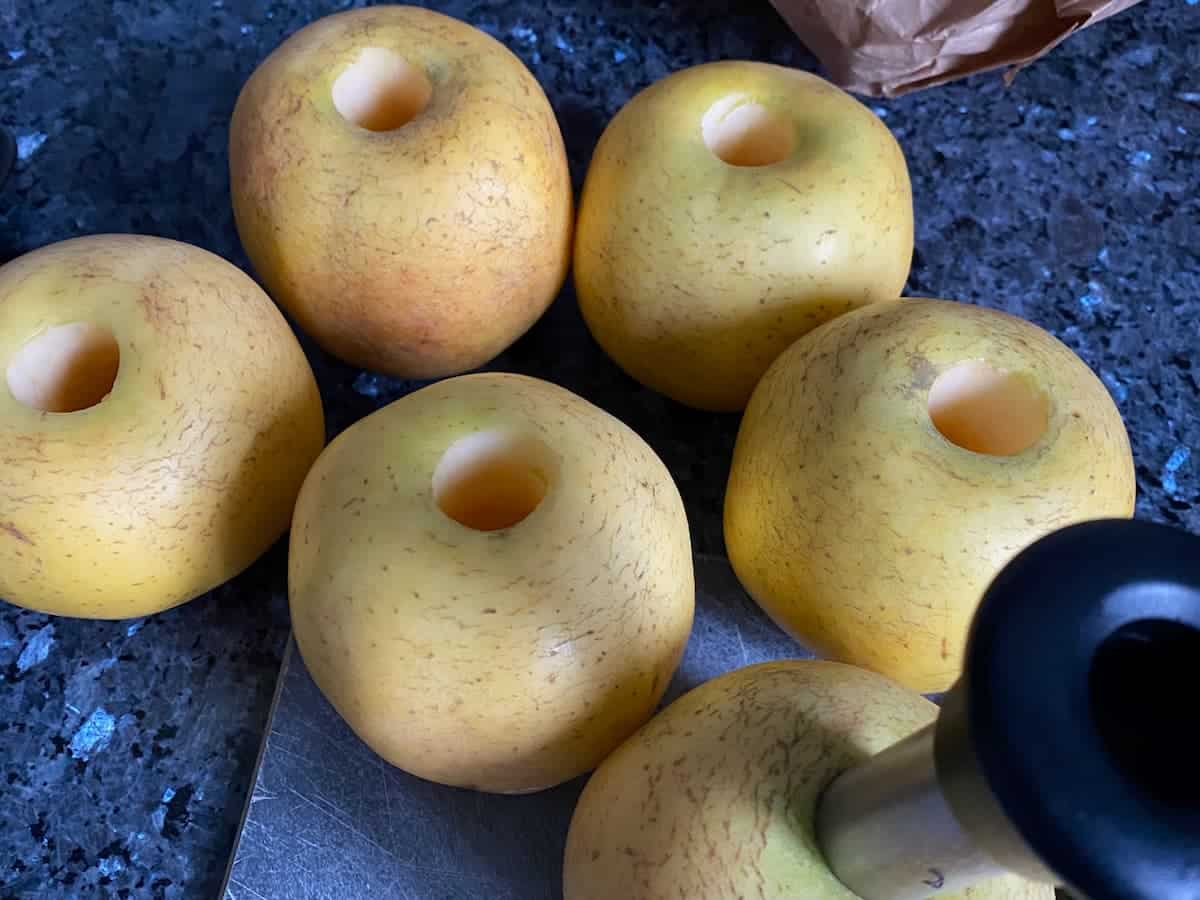
What Apples are Best for a Tarte Tatin?
Not all apples are ideally suited for a Tarte Tatin. I discovered the best way - by first getting it wrong.
Newly married, I was totally intimidated by my French Mother-in-Law's Tarte Tatin. Her dessert looked so sumptuous and grand with its glistening slices of warm caramelised apples sitting on top of a crispy pastry, just oozing with the sticky juices. How did she do it?
Pressing her short and simple recipe in my hand, I was assured it was easy and inrattable; "You can't go wrong," she said.
Well I did get it wrong.
For a start, I used apples that didn't survive the cooking process (Pink Lady) and when I quickly turned the pan upside down for the grand finale de-moulding moment, some of the apples stuck to the bottom and the rest sat there miserably as light, uncaramelised mush. I thought of inventing a new Tart with Apple Sauce but somehow it didn't have quite the same "accident appeal" as that of the elderly Tatin Sisters.
So, my lesson was learned. Use good quality firm and tart apples - the best, for example, are Granny Smith, Chantecler or French Golden Delicious.
For much more on apples including more apple recipes,
see my Market Produce Page on Apples.
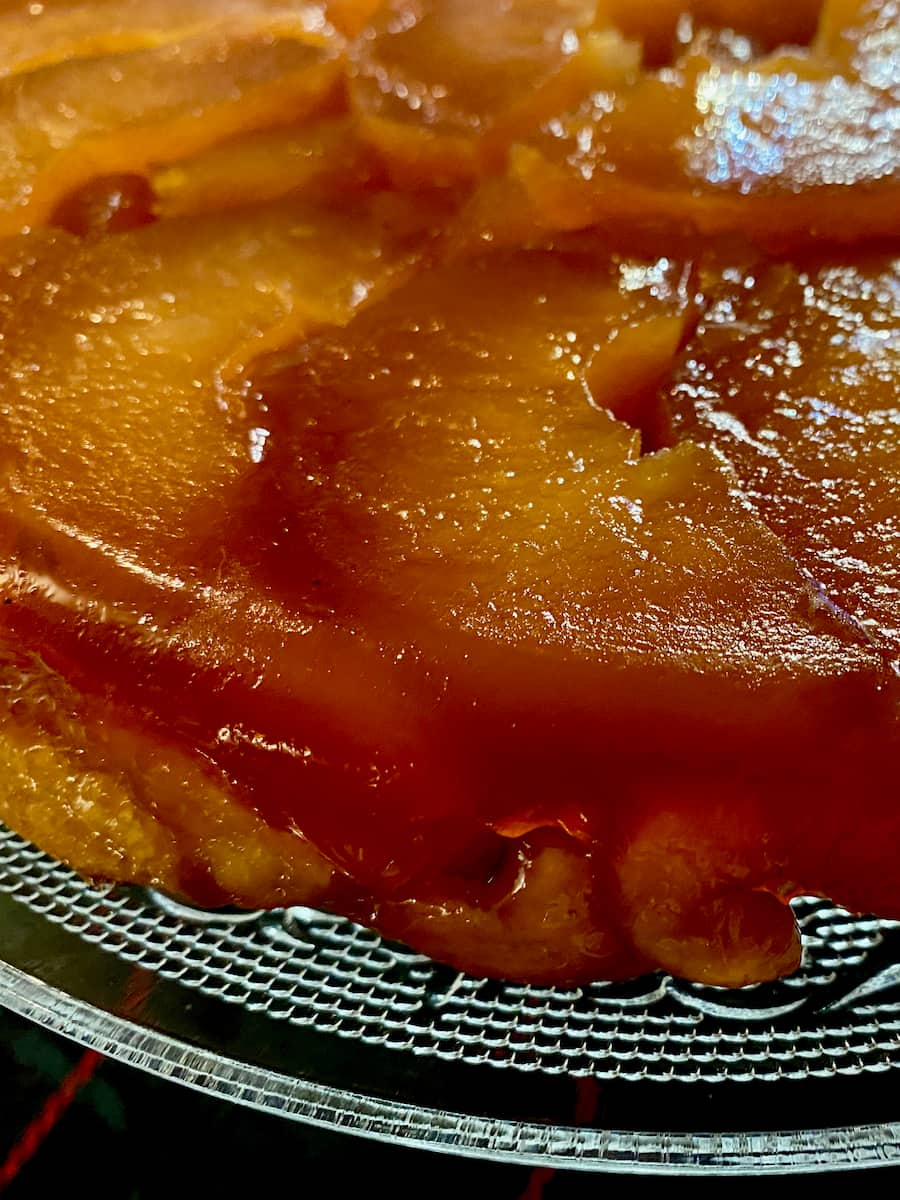
Can I make a Tarte Tatin with Pears?
Absolutely! Using this recipe, apples can be replaced with firm to medium pears (Conference, Williams, Hardy are best).
Although this can work well, pears are more juicy and contain more water, so there's more of a chance of a soggy pastry. As a result, I prefer this traditional version made with apples.
To avoid a soggy bottom with juicy pears in a tarte tatin, however, I developed an extra fondant upside down caramelised French Chocolate Pear Cake.
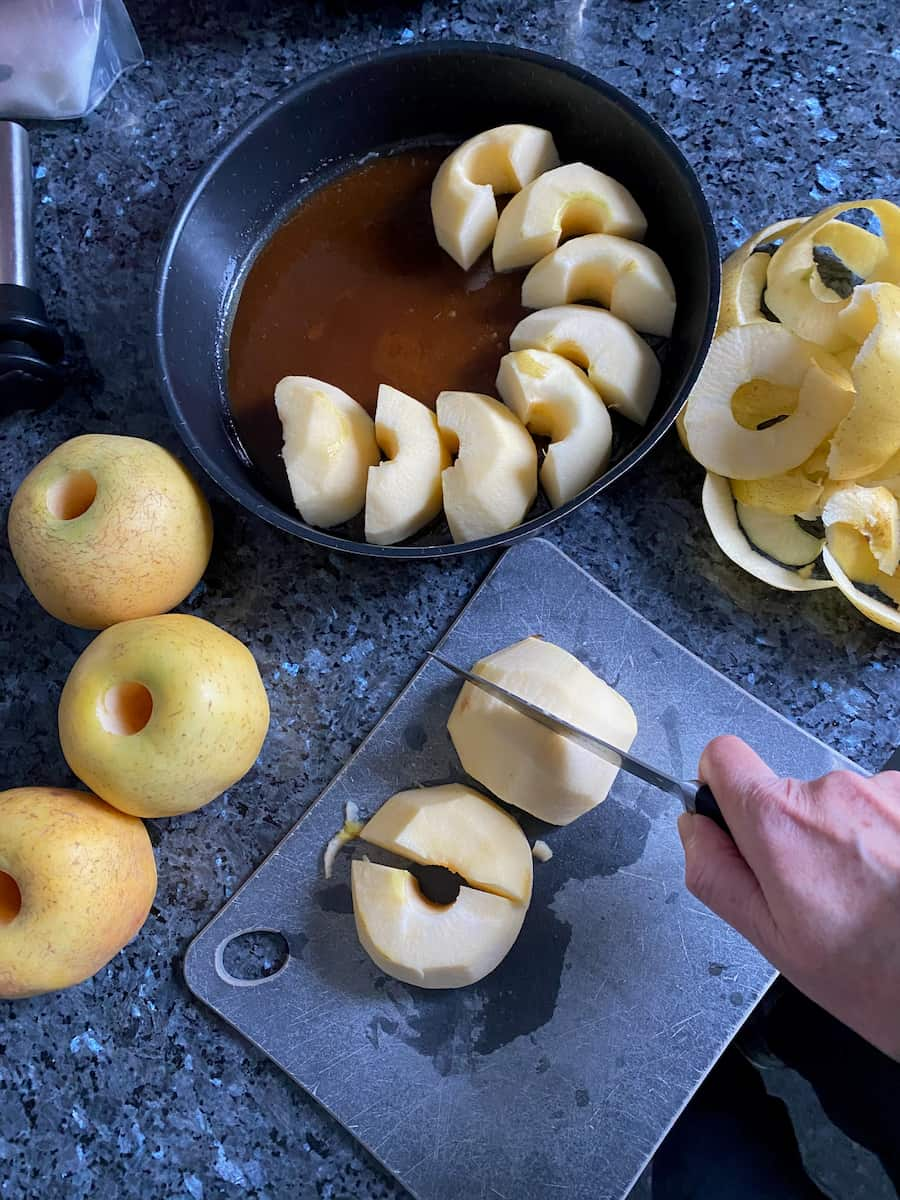
What is the Best Pan for Tarte Tatin?
For this recipe, I use a 23cm (9 inch) round x 5cm (2 inch) deep cake tin for best results. Even better if it's non-stick, as there's no need to butter the dish in advance. There's no need to buy any special kind of tarte tatin moulds. As it's an upside down tart, just a cake tin does the job well.
(As I have an induction hob, alas, my cake pans cannot first be used on the hob, hence why this recipe is made first making a caramel to line the pan.)
Alternatively, use a good heavy-bottomed ovenproof pan. The most important is that the pan should be able to be transferred easily to the oven. This means that making the caramel can be done directly from start to finish in the pan and saves on washing up.
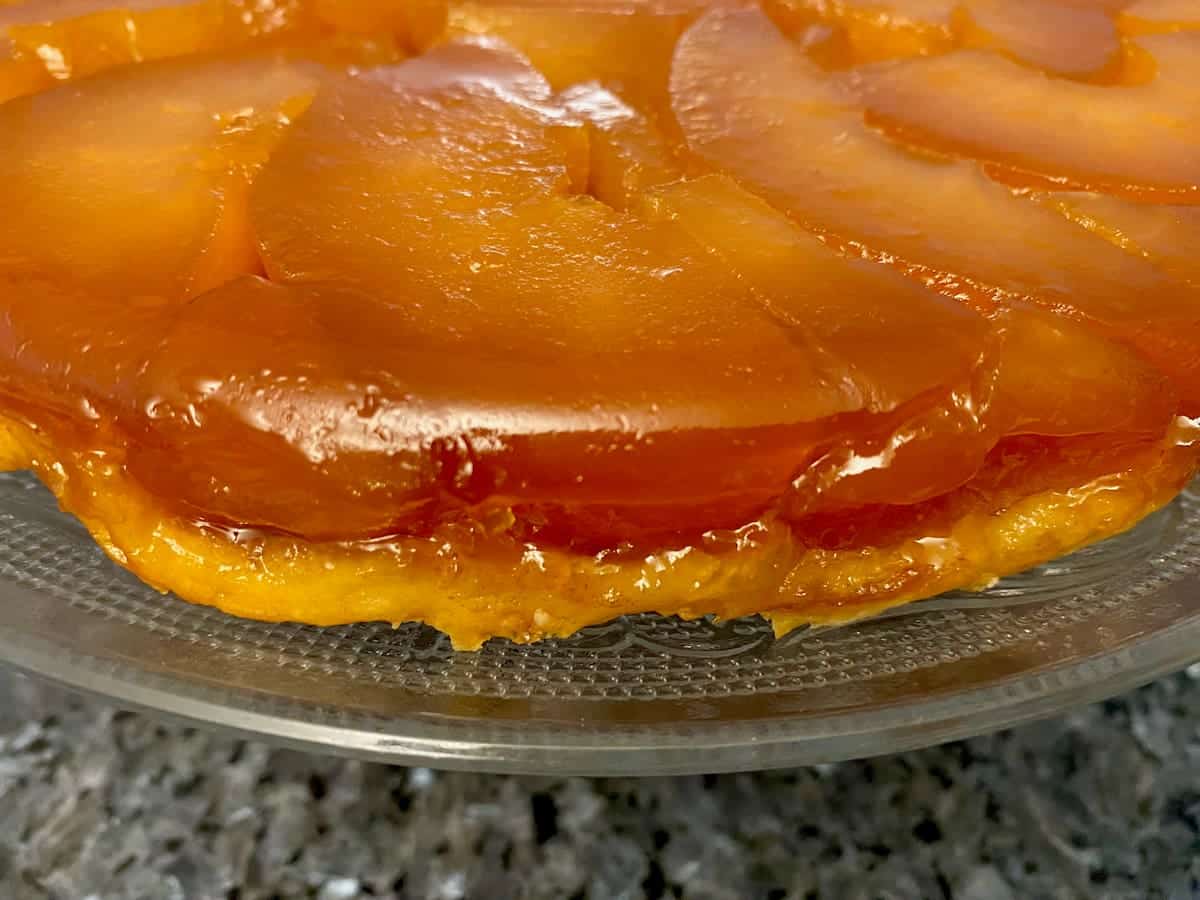
Tarte Tatin Recipe
To caramelise the apples for a tarte tatin, first make a caramel with water. This method is simply called a Wet Caramel and is so easy to make in just 10 minutes.
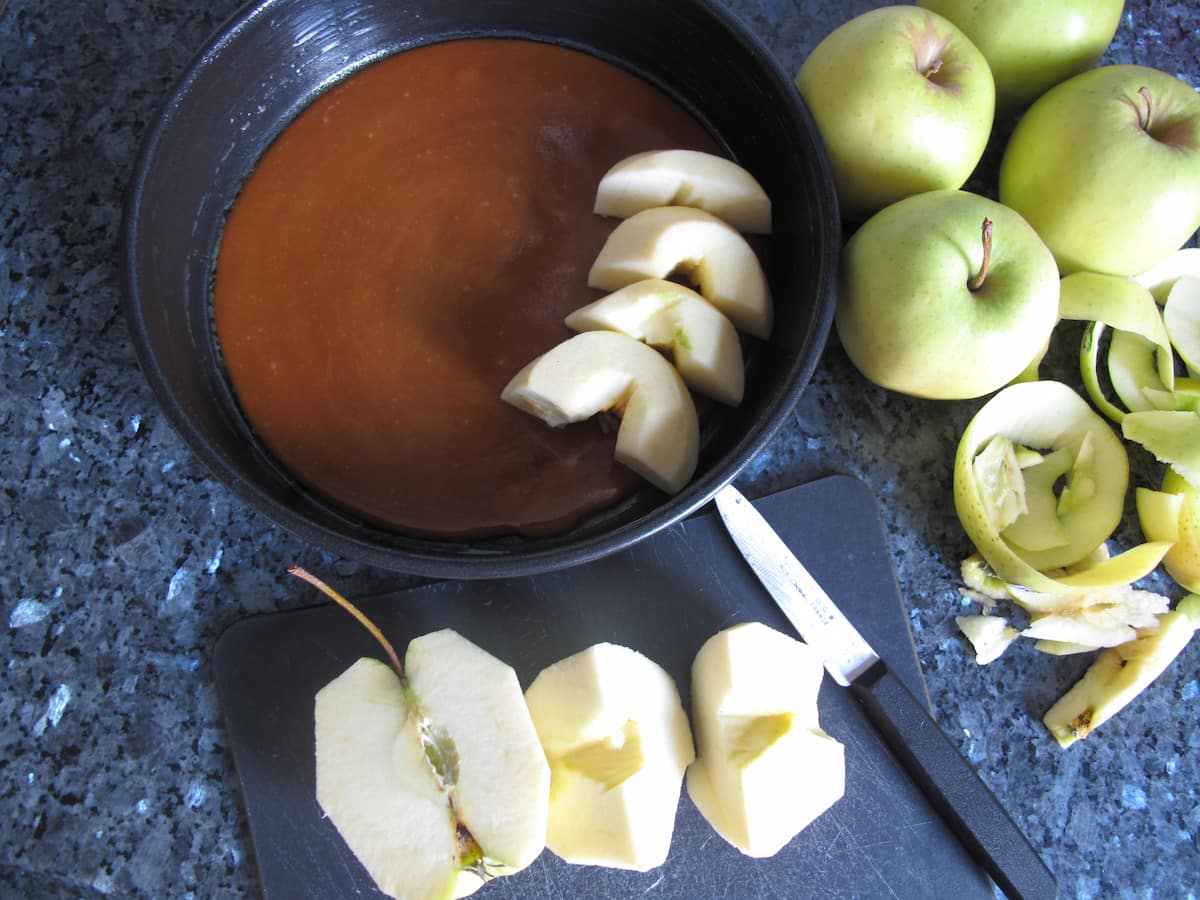
How to Make a Wet Caramel
This method of wet caramel hardens but doesn't get too hard, which makes it so much easier to work with. It's the classic caramel used to make flans - see my recipe video for Crème Caramel, where I demonstrate how to make a wet caramel.
First, place about 3 tablespoons of water in a saucepan with 120g of sugar. It shouldn't be on the heat. Swirl it around or stir slightly to help dissolve them slightly.
Then place on a medium heat without touching or stirring. Leave the sugar and water to work their magic! Keep your eye on it, as it could easily burn if unattended.

Gradually, during 10 minutes, the bubbles turn from clear to light gold to golden brown. When golden brown, add the butter and salt then it's possible to stir with a spoon.
When the caramel is smooth, pour immediately into the cake tin and the caramel will solidify pretty quickly. This will make it easy to stack the apples on top of it.
How to Prepare the Apples for the Tart Tatin
Once the caramel is poured into the tin, prepare the apples. Work quite quickly so they don't brown too much.
First cut apples in half and core them (I like to core them first with an apple corer, then half). Then cut them in half again horizontally. Pack them upright on top of the hardened caramel as close as possible together.
Fill in any gaps with leftover apple bits then top evenly with the extra butter and sugar and bake for at least 30 minutes to caramelise the apples in the oven.
Remove then top with the circle of pastry. Pierce some holes to let air escape then bake further in the oven for another 20 minutes or longer if you prefer the apples darker.
Leave to cool for about an hour. Loosen the pastry by running a knife around the side of the pan then upturn on to a dish.
How do you Stop Tarte Tatin From Getting Soggy?
Who loves to talk about soggy bottoms? It's a touch of British Bake-Off fever. Don't worry about this. In fact, it will naturally be a little juicy and that's perfectly normal with the juices of the apples.
However, I recommend you make the recipe all in one go to avoid the pastry going soggy. If you plan on making this in advance and caramelising the apples first, then wait for them to cool completely before adding the pastry.
So make the recipe all in one go, leave the tart to cool then upturn onto a serving plate. If serving later, hold back any juices left in the pan and pour on top when ready to serve.
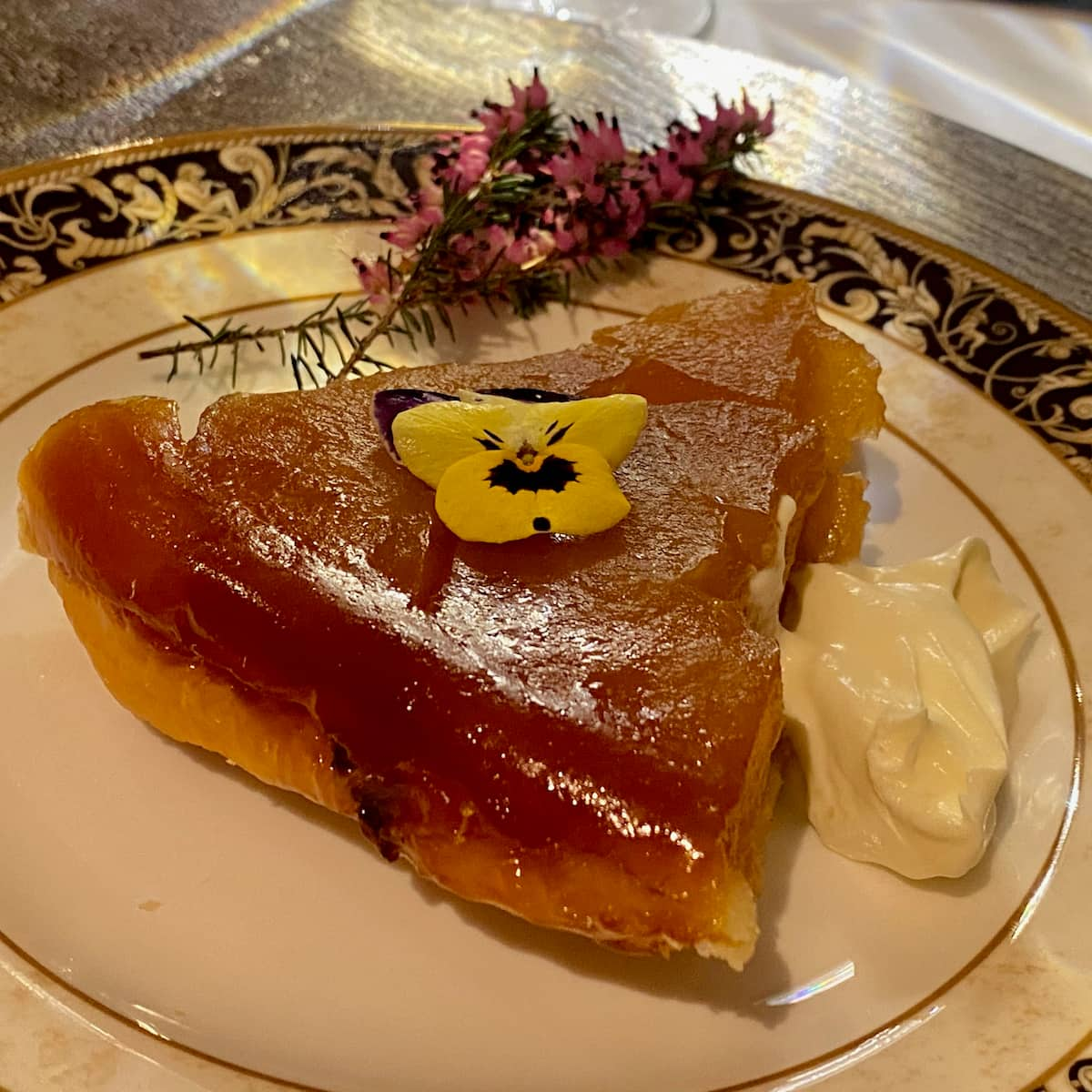
Should It Be Served Hot or Cold?
The Tarte tatin is best served warm or at room temperature, rather than hot or cold. We love it served just on its own, but many restaurants in Paris accompany it with a spoonful of full fat crème frâiche. Can't find crème frâiche? The best alternative is Greek yogurt.
For something different, serve with , great with French apple tarts. Alternatively, for something more adult, accompany it with this boozy Calvados Cream or Drambuie ice cream for a Scottish-French dessert.
French Apple Tarte Tatin vs Scottish
Speaking of the Auld Alliance between France and Scotland, I have a couple of Scottish cookbooks that call this an Auld Alliance Apple Tart! Do you think Mary Queen of Scots brought this to France before the Tatin sisters? Hm. If you know of the Scottish roots of this dessert, then please let me know in the comments below.
For comforting desserts, see more seasonal winter recipes.
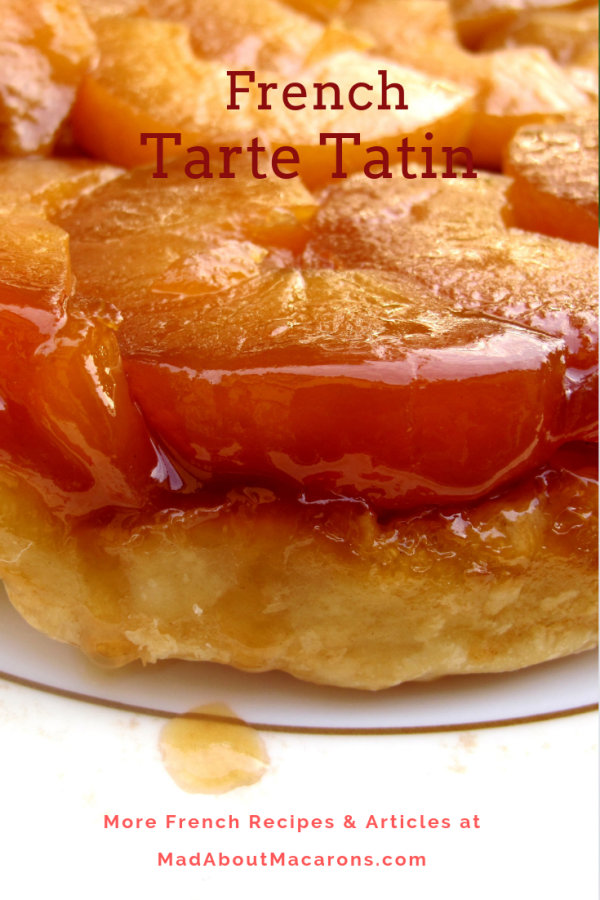
Classic Tarte Tatin
The authentic classic recipe for a Tarte Tatin uses shortcrust pastry (pâte brisée) as the base. Instead, I like to cheat to make this much quicker and easier using ready-made shortcrust or puff pastry (all butter).
Want to cheat further? Make a batch of salted caramel sauce and the first step is already prepared in advance!
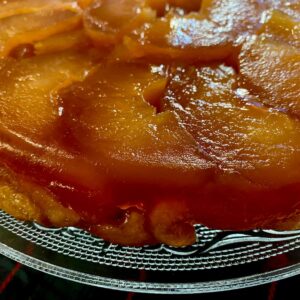
Tarte Tatin Recipe
Equipment
- non-stick cake tin 23 x 5cm (9 x 2 inch)
Ingredients
- 5-6 apples Golden Delicious or Granny Smith
- 200 g (7oz) ready-made puff pastry thawed, if frozen and rolled out
- 3 tablespoon water
- 120 g (4½oz/ ⅔ cup) granulated sugar plus 2 tablespoon for sprinkling
- 30 g (1oz/2 tbsp) unsalted butter plus 15g/1 tablespoon extra
- 15 g (1 tbsp) Calvados (optional)
- pinch salt (fleur de sel, Maldon or Celtic sea salt)
Instructions
- In a heavy bottomed saucepan, stir the water and sugar together until slightly dissolved (off the heat). Then, over a medium heat, leave the sugar alone to bubble and simmer until a light golden brown caramel forms (no need to stir at all until the caramel turns colour). This will take about 10 minutes.Stir in the butter (and salt if using) and splash of Calvados (if using) until the caramel is smooth and immediately pour into the cake tin.
- Preheat the oven to 190°C/170°C fan/375°F (gas 5). Peel the apples, cut them in half, remove the cores with a sharp knife (or use an apple corer) and cut them again horizontally.
- Arrange the apples upright in a circle and pack them as tight as you can (they’ll shrink while cooking), filling as much space as possible in the middle. Cut up any leftover apple and stuff them into the spaces.Top evenly with the extra butter cut into small bits (or brush with melted butter) and lightly sprinkle over the extra 2 tablespoons of sugar. Bake in the oven for 30 minutes.
- Remove the caramelised apples from the oven to cool slightly as you prepare the pastry.
- Ideally your puff is ready rolled so there’s no need to do anything. (If the puff pastry is in a block, roll it out to about 2mm thickness and cut out a circle very slightly larger (2-3cm) than the size of the pan you’re using). Place the pastry circle on top of the apples, tucking in the sides as far down the edges as you can, as it will neatly hold the apples when turned over at the end. Pierce a few small holes in the pastry to allow any steam to escape – this will prevent the puff pastry from puffing up too much while baking.
- Bake in the oven for a further 25-30 minutes (another 5 minutes if you like your apples darker), or until the pastry is golden brown and the apple juices bubble around the edges.
- Leave to cool for about an hour then run a knife along the edges just to help release the sticky beauty. To turn over the tart, cover the pan with a large deep plate (to catch any juices). Hold the pan and plate together and flip upside down quickly, pastry side down.
Notes
Serve either at room temperature or slightly warmed with a dollop of good quality (full fat) crème fraîche or ice cream. Alternatively, add some Calvados Cream or for something different, Drambuie ice cream for a boozy, adult dessert. For more on apple varieties for baking, see the apple page. Measures: Please note that all my recipes are best made using digital kitchen scales in precise metric grams. Both ounces (and cups) are given as an approximate guide.
This recipe was first published 8 October 2015 but is now completely updated.
Looking for a savoury recipe? Try this French Onion Tarte Tatin.

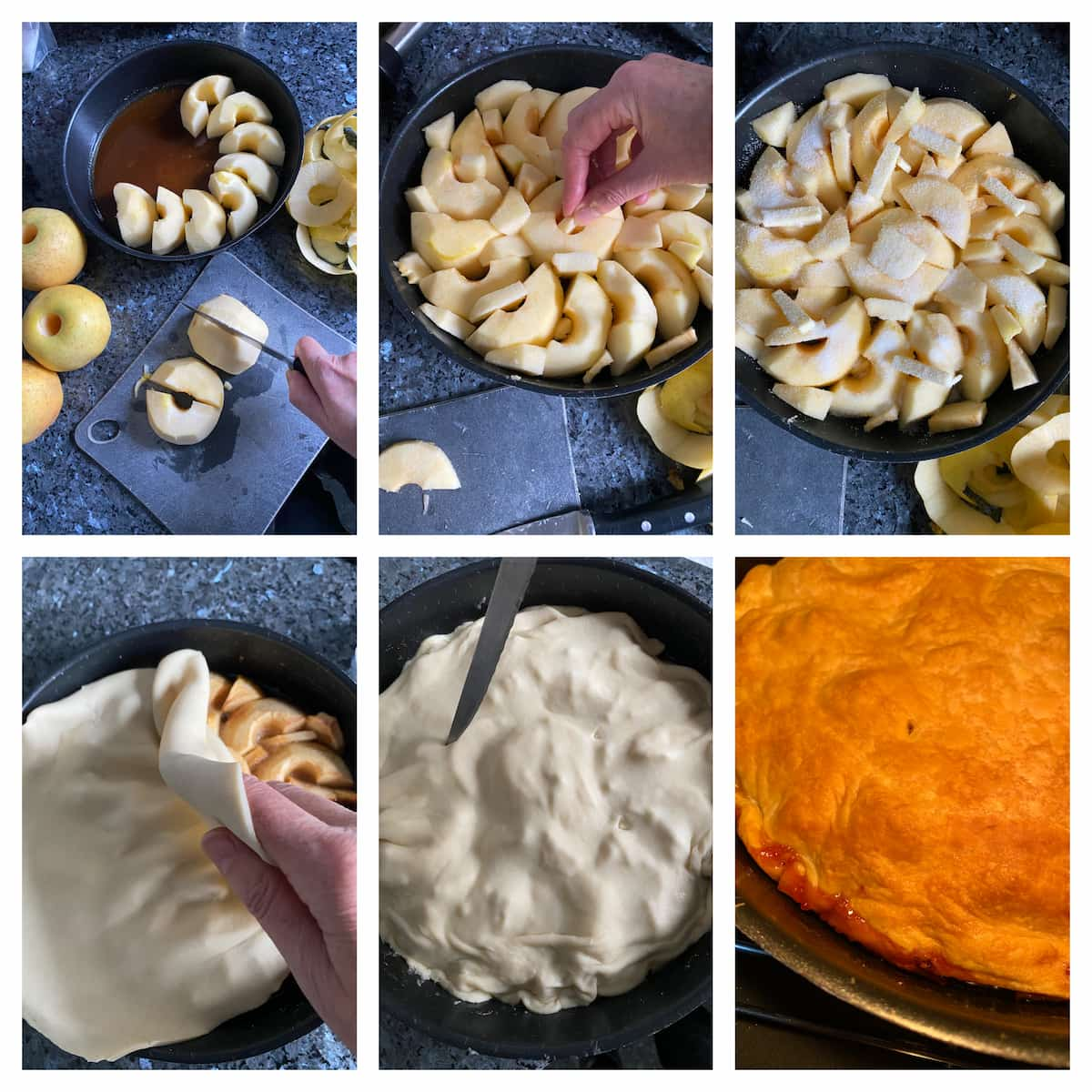

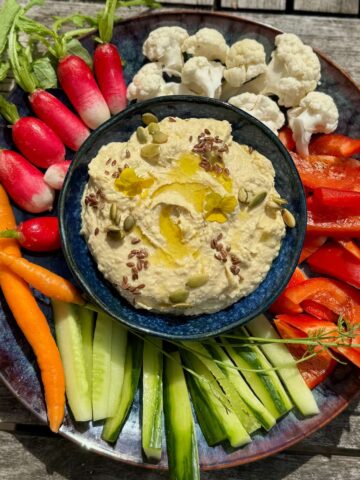
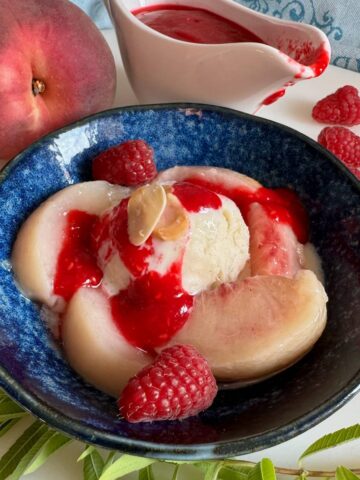
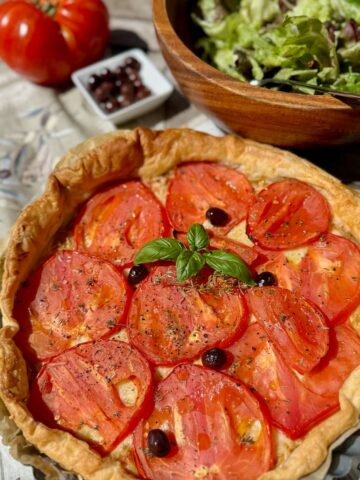

Christina Conte
Well, it took me a few years, but I finally made your recipe: BRILLIANT result! Was perfectly sweet (not too much) and popped out like magic with the most perfect color!
Thanks for the fab recipe, Jill!
Jill Colonna
So happy to hear this, Christina. It's hard to dose sweet caramel without being too sweet and so this is an extra bonus to hear you like that too.
debra alberts
many thanks
Jill Colonna
It's a pleasure, Debra.
Angie
Why does my caramel always crystallize? ?
Jill Colonna
Hi Angie,
It could be because you're continuing to stir the caramel once it starts to heat. Just leave it alone until it starts to colour. I'd recommend putting a lid on it for no more than a minute if you see it starting to crystallise.
Enrique
Hi i prepare the tart tatin, which other fruits can i use to adapt at this clasical recipe. Thanks
Enrique
Yes it wonderful, I tried to make it. It's so delicious, made with sweet pastry or puff pastry.
David
So simple, yet so elegant. Your apple advice is so important. I made the same mistake when I made one many years ago... It took me a long time to get my nerve up again to try!
Jill Colonna
Glad this helped David. It's so basic, but nobody told me so I learned the hard and mushy way! It's such an easy dessert and agree, it just takes a bit of nerve and in the end it's a lot easier than we thought.
Parisbreakfast
I've made tomato tatin and potato tatin but I have a deep fear of making caramel in the pan.
Please do a post? ;((
Susan
I have being making Tarte Tatin for years and have very simple method to make it. I use a Visions brand frying pan ( clear glass)You could use any heavy frying pan with high sides that can go into the oven.
I put the sugar and butter in the pan on the stovetop and let it caramelize, medium heat. Keep a close watch. so it does not burn I have pre-sliced 3-4 Granny Smith apples into small wedges. When the caramel is starting to turn golden, I remove pan from heat and carefully arrange the slices in a circle starting from the outside. edge This is to make a pretty design when the tarte is inverted on a plate after baking .
Place pan back on burner so the caramel bubbles between the slices just for a couple of minutes. Turn off stove top and place your choice of pastry on top folding the edges under. Either regular pie crust or puff pastry works well. Bake at 375 degrees for about 25 minutes or until crust is lightly golden and you can see the caramel sauce bubbling.. Remove from oven ,letting it cool for a couple of minutes, Run a knife around the edge to make sure there is no sticking on the edges and invert carefully on a plate. Be very careful as caramel will still be very hot.
I have never had a problem with losing any of apples to the bottom of the pan.
Enjoy
Jill Colonna
Thanks for sharing your version with us Susan and for taking the time to write it all out! I used to make it like this too - my mother-in-law does it like this. As long as we all arrive at the same delicious result! Bon dimanche x
David
Funny, Jill, I was just reading from my 1960s cookbook from Chez Maxim, planning a post about Tarte Tatin! Love the story and, while it may not be true, why let the facts spoil a good story? Your Tatin looks perfect!
Jill Colonna
Wow - you've got the Maxim cookbook? Now that's interesting to hear what they say about it. I was even going to phone them then thought I was going mad... So it's not necessarily true about Maxims?! 🙁 Thanks for the info and for your kind words David.
Jean-Pierre
Had heard of the history but didn't know about Maxims Jill. Love this dessert. Make it quite often but never pierced a hole in the pastry. Must try it next time - thanks.
Jill Colonna
I just pierced it since the puff pastry would puff up too much in the oven. Now it behaves! Thanks Jean-Pierre.
Liz
Picture perfect, Jill!!! This tarte tatin is truly gorgeous.
Jill Colonna
Really appreciate your kind words and popping in Liz x
Christina @ Christina's Cucina
This is PERFECT, Jill! I tried a Tarte Tatin once, but it didn't turn out too well. Will have to give it a go again, but have to reseason my cast iron pan and a new oven would help! It's going to happen, soon! 🙂
Jill Colonna
Well I do wish you a new oven soon Christina. I'm sure there's an oven fairy out there if you say you have to make a tarte tatin!